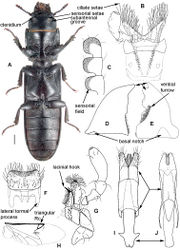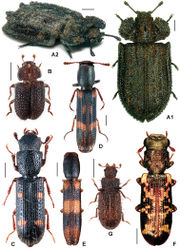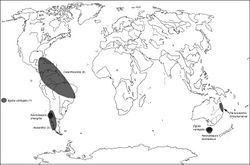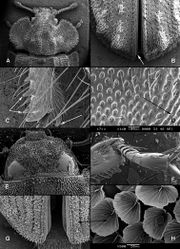Acalanthis
| Notice: | This page is derived from the original publication listed below, whose author(s) should always be credited. Further contributors may edit and improve the content of this page and, consequently, need to be credited as well (see page history). Any assessment of factual correctness requires a careful review of the original article as well as of subsequent contributions.
If you are uncertain whether your planned contribution is correct or not, we suggest that you use the associated discussion page instead of editing the page directly. This page should be cited as follows (rationale):
Citation formats to copy and paste
BibTeX: @article{Kolibáč2013ZooKeys366, RIS/ Endnote: TY - JOUR Wikipedia/ Citizendium: <ref name="Kolibáč2013ZooKeys366">{{Citation See also the citation download page at the journal. |
Ordo: Coleoptera
Familia: Trogossitidae
Name
Acalanthis Erichson, 1844 – Wikispecies link – Pensoft Profile
- Acalanthis Erichson, W. F. 1844: 446.
Type species
Acalanthis quadrisignata Erichson, 1844 [by monotypy]
Léveillé, A. 1910: 4. Arias, E. et al. 2009: 39. Crowson, R. A. 1964a: 299 (larva, described as Phanodesta). Crowson, R. A. 1970: 13. Kolibáč, J. 2005: 40. Kolibáč, J. 2006: 106 (larva; see Crowson 1964a[1])
Remarks
An antennal apex I figured (Kolibáč 2005[2]: 89, Pl. 1-Fig. 5) was associated with Acalanthis quadrisignata in error, as correctly noted by Arias et al. (2009)[3]. The drawing probably belongs to Calanthosoma flavomaculata.
Description
Body size: 6.0–9.0 mm. Body shape elongate. Gular sutures narrow, subparallel at apex. Frontoclypeal suture absent. Frons: longitudinal groove or depression absent. Cranium ventrally: tufts of long setae at sides present. Submentum: ctenidium absent. Antennal groove present. Eyes: size moderate Eyes number: two. Epicranial acumination moderate. Lacinial hooks: two. Galea: shape sub-clavate. Galea: ciliate setae absent. Mediostipes-Lacinia partially fused. Palpifer: outer edge even. Mandibular apical teeth number: two, horizontally situated. Mola reduced but present. Penicillus (at base) present (fine, often membranous). Pubescence above mola or cutting edge present. Ventral furrow present. Basal notch moderate. Labrum-Cranium not fused. Epipharyngial sclerite present. Lateral tormal process: projection curved downwards, processes not connected (Airora). Ligula: ciliate setae absent. Ligula rigid, weakly retroflex, deeply emarginate. Hypopharyngeal sclerite H-shaped. Antenna 10-segmented, Antennal club asymmetrical, sensorial fields present. Front coxal cavities externally closed, internally open. Pronotum cordate. Prepectus absent. Middle coxal cavities closed. Elytra: long hairs present. Epipleuron moderate. Elytral interlocking mechanism present, carinae reduced. Elytral punctation regular, scales absent. Wing: radial cell triangular, wedge cell present, cross vein MP3-4 present, cross vein AA1+2-3+4 absent. Front tibiae: spines along side moderate. Hooked spur present. Claws: denticle absent. Parasternites number along ventrites III–VII: one. Spiculum gastrale absent. Tegmen composed of three parts. Coxitae undivided.
Larva: Frontal arms V-shaped. Epicranial stem reduced. Endocarina present. Antennal joints 1 and 2 elongate. Thoracic sclerites pattern (dorsally) 1-2-2. Tergite IX depressed. Urogomphi present, hooked; median process absent.
Biology
Predatory. Crowson (1964a)[1] remarked “numerous insect fragments in gut” of an assumed Phanodesta larva but, as he noted later (1970[4]: 1), the larva probably belongs to some species of Acalanthis. Its brief description in his key (1964a[1]: 299) in fact agrees perfectly with the larval characters of Egoliini. The adult gut contents of Acalanthis quadrisignata included insect fragments (Crowson 1964a[1]). Elizabeth Arias and colleagues (Arias et al. 2009[3]) caught numerous Acalanthis specimens by canopy fogging and beating vegetation in forests, yielding a range of species including some Nothophagus, Araucaria, Schinus, and Rhaphitamnus.
Distribution
Temperate forests of central Chile and Argentina (Arias et al. 2009[3]).
Species:
Acalanthis mirabilis Reitter, 1876; Chile (AL, varA)
Léveillé, A. 1910: 4. Arias, E. et al. 2009: 40
Acalanthis quadrisignata Erichson, 1844; Chile (AL, varA)
Léveillé, A. 1910: 4. Arias, E. et al. 2009: 39. Kolibáč, J. 1999b: 12. Kolibáč, J. 2005: 40 (redescription)
Acalanthis semimetallica Fairmaire, 1861 (Clerus); Chile (AL, varA)
Léveillé, A. 1910: 4. Arias, E. et al. 2009: 41
Taxon Treatment
- Kolibáč, J; 2013: Trogossitidae: A review of the beetle family, with a catalogue and keys ZooKeys, 366: 1-194. doi
Other References
- ↑ 1.0 1.1 1.2 1.3 Crowson R (1964a) A review of the classification of Cleroidea (Coleoptera), with descriptions of two genera of Peltidae and of several new larval types. Transaction of the Royal entomological Society of London 116: 275-327.
- ↑ Kolibáč J (2005) A review of the Trogositidae. Part 1: Morphology of the genera (Coleoptera, Cleroidea). Entomologica Basiliensia et Collectionis Frey 27: 39-159.
- ↑ 3.0 3.1 3.2 Arias E (2009) A review of the Chilean Egoliini (Coleoptera: Trogossitidae) with description of a new species of Necrobiopsis Crowson. Zootaxa 2170: 37-45.
- ↑ Crowson R (1970) Further observations on Cleroidea (Coleoptera). Proceedings of the Royal entomological Society of London (B) 39: 1-20.
Images
|



